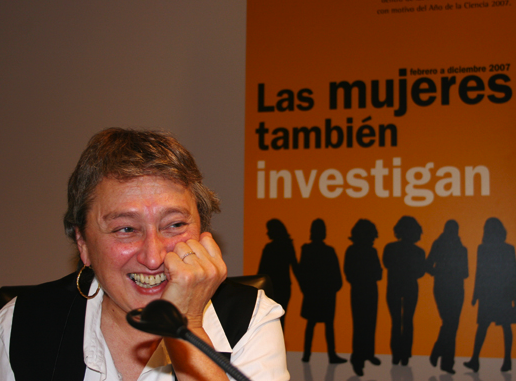Lynn Margulis was a contemporary of the astronomer Carl Sagan and Robert Whitaker, with whom she proposed a new classification of living beings into five kingdoms.
Lynn Margulis is one of the scientists who has contributed with her proposals to the development of evolutionary biology. Some, like Antoinette Brown Blackwell, dared to question some of Darwin's conclusions, who considered that "the evolution had made man superior to woman." Barbara McClintock or Esther Lederberg, among others, discovered transposable genetic elements and horizontal gene transfer in bacteria, respectively, discoveries that have subsequently been of great importance for understanding evolution.

Lynn Margulis
Chicago, 05-03-1938 — Amherst (Massachusetts), 22-11-2011
Period of activity: 1966 — 2011
Geographical classification: America > United States
Socio-cultural movements
Groups by dedication
Scientists > Biologists > Zoologists
Writers > Journalists / Chroniclers > Literary, music, etc. critics
Context of feminine creation
Review
We owe the theory of endosymbiosis to Lynn Margulis, a theory that explains the emergence of eukaryotic cells from primitive prokaryotic organisms. Lyn Margulis took up the evolutionary theories of late 19th century scientists such as Konstantin Mereschikowski, who proposed an evolutionary model based on cooperation (symbiosis) and not on the struggle and survival of the fittest. Margulis reformulated the theory to explain the origin of mitochondria and chloroplasts in eukaryotic cells from the cooperation of different primitive prokaryotic organisms through endosymbiosis. Later, together with the scientist Robert Whittaker, she proposed a classification of living beings into five kingdoms based on symbiogenesis (Monera, Protoctists, Plants, Animals and Fungi), a proposal now accepted by the entire scientific community.
Activities
Justifications
Biography
Her family name was Lynn Petra Alexander. She was the eldest of four sisters, from a Jewish family.
It was after marrying her second husband, Thomas Margulis (the first was Carl Sagan), that she adopted Margulis as her surname for which she is known. She had a daughter and a son with Carl Sagan, and two others with Thomas Margulis.
She graduated in Science at the University of Chicago, studied a master’s degree at the University of Wisconsin and obtained a PhD in Berkeley (California).
She was a professor at the University of Massachusetts, where she worked at the Geoscience department.
Since the beginning of her career, she felt attracted to microorganisms, and her interest to include them on the study of genetics increased when she met E. Wallin, Konstantin S. Merezhkovsky and A.S. Famintsyn. They proposed that some parts of the eukaryotic cells could be evolved forms of free-living bacteria. Based on these hypotheses and in accordance with the data obtained from her own research, Margulis developed the theory of endosymbiosis. This theory is truly revolutionary and original within evolutionary theories, as it relies on cooperation between organisms and not on the struggle between them as the driving force of evolution.
Although her theoretical approach initially generated much reticence, it is now unanimously accepted by the entire scientific community and her theory of endosymbiosis is present in all textbooks.
Margulis was awarded numerous prizes and recognitions throughout her professional life. She was a member of the Royal Academy of Sciences of the United States and a brilliant international lecturer. Throughout her professional career, Margulis collaborated with different universities in France, Germany, Switzerland, Mexico, Italy, and Spain.
Works
Lynn Margulis has more than one hundred publications between books and scientific articles. Some of them are the following:
Margulis, Lynn. El origen de la célula. Editorial Reverte S. A., 1988
Margulis, Lynn; Olendzenski, Lorraine. Evolución ambiental: efectos del origen y evolución de la vida sobre el planeta tierra. Alianza Editorial S.A., 1996
Margulis, Lynn; Sagan, Dorion. ¿Qué es la vida? Tusquets Editores, 1996
Margulis, Lynn; Sagan, Dorion. ¿Qué es el sexo? Tusquets Editores, 1999
Margulis, Lynn. Peces luminosos: historias de amor y ciencia. Tusquets Editores, 2002
Margulis, Lynn. Una revolución en la evolución. Universitat de valencia. Servei de publicacions, 2002
Margulis, Lynn; Sagan, Dorion. Captando genomas: una teoría sobre el origen de las especies. Editorial kairos, s.a., 2003
Bibliography
Martínez Pulido, Carolina. 2014. Mujeres con Ciencia, (July 2021) https://mujeresconciencia.com/2014/07/16/lynn-margulis-la-vida-desde-la-cooperacion-microbiana/
Mujeres de Ciencias, (July 2021) https://mujeresdeciencias.blogia.com/2007/020701-lynn-margulis-boston-1938-.php
Wikipedia. (July 2021) https://es.wikipedia.org/wiki/Lynn_Margulis
Didactic approach
Biology-Geology 1st, 3rd ESO Block: The Cell
Biology-Geology 4th ESO Block: Genetics and Evolution